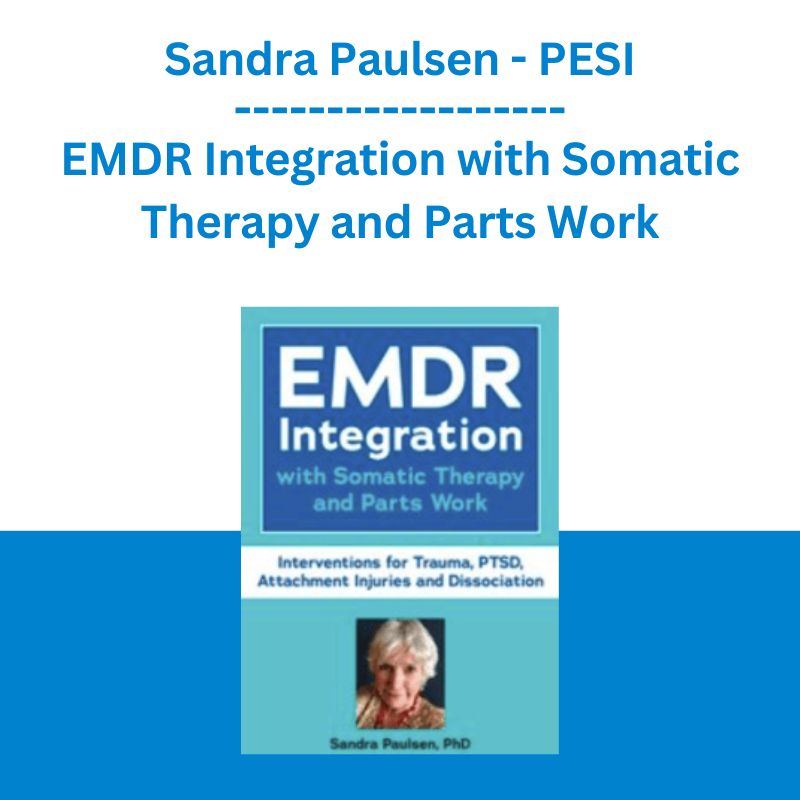*** Proof of Product ***

Exploring the Essential Features of “Sandra Paulsen – PESI – EMDR Integration with Somatic Therapy and Parts Work: Interventions for Trauma, PTSD, Attachment Injuries and Dissociation”
Speaker: Sandra Paulsen, PhD
Duration: 6 Hours
Format: Audio and Video
Copyright: Oct 03, 2022
Media Type: Digital Seminar
Description
EMDR, parts work, and somatic therapy are three of the most popular approaches right now…
But, the problem is that there is little training on how to integrate these incredibly effective modalities. Here’s the good news for you…
With 30 years’ experience teaching clinicians like you, a premier expert in EMDR, somatic and parts work therapy, Sandra Paulsen, PhD, will guide you through the steps to enhance EMDR by integrating these powerful approaches.
From Sandra’s step-by-step teaching style, you’ll gain the skills to modify and customize EMDR at any stage of treatment, for any type of client trauma. You’ll be able to target your client’s trauma whether it’s stored in the body, memories or present. Walk away with skills and techniques to:
- Create step-by-step treatment plans, so you know exactly what to do in each phase of EMDR treatment
- Do somatic work with clients that frees their body from trapped pain
- Integrate parts work to resolve childhood trauma and other internal conflicts
- Harness the power of neuroaffective approaches to calm your client’s nervous system
Get the training to harness the power of three revolutionary approaches to psychotherapy – enhance your practice and offer a path forward for your client’s healing!
Register now!
Speaker
Sandra Paulsen, PhD
Paulsen Integrative Psychology
Sandra Paulsen, PhD, is an international instructor, author and illustrator of principles and procedures for using EMDR with complex trauma including structural and somatic dissociation and trauma held in implicit memory. She has published widely on the combination of EMDR with ego state therapy, somatic methods and early developmental repair strategies. Her books include coediting The Neurobiology and Treatment of Traumatic Dissociation: Toward an Embodied Self, with Ulrich Lanius and Frank Corrigan. She wrote and illustrated Looking Through the Eyes of Trauma: An Illustrated Guide for EMDR Therapists and Clients, as well as When There Are No Words: EMDR for Very Early Trauma in Implicit Memory. She coauthored and illustrated a children’s book that is also very useful for dissociative adults called All the Colors of Me: My First Book on Dissociation, with Ana Gomez.
Sandra is a Fellow of the International Society for the Study of Trauma and Dissociation. She developed the first protocol for the use of EMDR with highly dissociative individuals, publishing cautions about EMDR with dissociation, and for first urging the screening of every client for dissociation before administering EMDR. She has trained hundreds of mental health professionals in these special procedures since 1993. She has numerous online workshops available through the Steve Frankel Group at sfrankelgroup.com.
Speaker Disclosures:
Financial: Dr. Sandra Paulsen has employment relationships with Paulsen Integrative Psychology, PLLC, Paulsen Consulting Resources, and Steve Frankel Group. She receives a speaking honorarium from Alpha-Stim. Dr. Paulsen receives royalties as a published author. She receives a speaking honorarium from PESI, Inc. All relevant financial relationships with ineligible organizations have been mitigated.
Non-financial: Dr. Sandra Paulsen is a fellow of the International Society for the Study of Trauma & Dissociation and is a member of the EMDR International Association. She is an advocate for EMDR for trauma treatment.
Objectives
- Practice questions at intake point to case formulation and treatment planning.
- Evaluate six somatic methods to enhance trauma processing and embodiment.
- Conceptualize three critical cornerstones of ego state therapy.
- Practice four modifications to the standard EMDR protocol when using the Early Trauma modifications for trauma in the attachment period.
- Evaluate four neuroaffective strategies that facilitate trauma processing efficacy.
- Practice dialogues to connect with client’s traumatized parts sensitively.
Outline
How & Why to Modify EMDR?
- Basics of the initial interview
- Tune into client’s unspoken story
- The guiding decision process for integration
- When to use standard vs modified EMDR
EMDR for Early Trauma & Neglect
- Apply main EMDR Strategies
- Determine level of “aggressor loyalty”
- Spot missed milestones
- Birth, attachment & narcissistic parenting trauma
- Repair client’s imagination
- Specific strategies:
- Containment
- Resource State
- Reset affective circuits
Somatic Empathy & The Body
- Is the client embodied?
- Test somatic sensation tolerance
- Identify implicit memories
- Listen to your clients non-verbal “bio-story”
- New evidence-based strategies
- Tracking, spontaneous oscillation, somatic micromovements
Parts Work Therapy for High Dissociation
- Speak directly to clients’ parts
- Dissolve client’s loyalty to aggressor
- Visually access client’s “dissociative table/conference room”
- Disempower internalized “head honchos”
- Be an “ACT-AS-IF” Architect
- Containment strategies, Trauma Accessing, Desensitization & more
Brining it All Together: NEST™ Principles, A Framework for Integration
- Assessment and screening
- Neuroaffective strategies
- Embodiment through Somatic Therapy
- Self-System through Ego State Therapy
- Integrated Therapy for trauma resolution
- Create a NEST™ treatment plan
- Know when and how to incorporate each principle
- Case Studies:
- Greta – PTSD, anxiety, hears voices, disordered eating
- Frank – Failed relationships, numb, intellectualizes, substance abuse
Target Audience
- Counselors
- Social Workers
- Psychologists
- Psychiatrists
- Psychiatric Nurse Practitioners
- Therapists
- Art Therapists
- Marriage & Family Therapists
- Addiction Counselors
- Physicians
- Nurses
- Other Mental Health Professionals
Please see the full list of alternative group-buy courses available here: https://lunacourse.com/shop/









